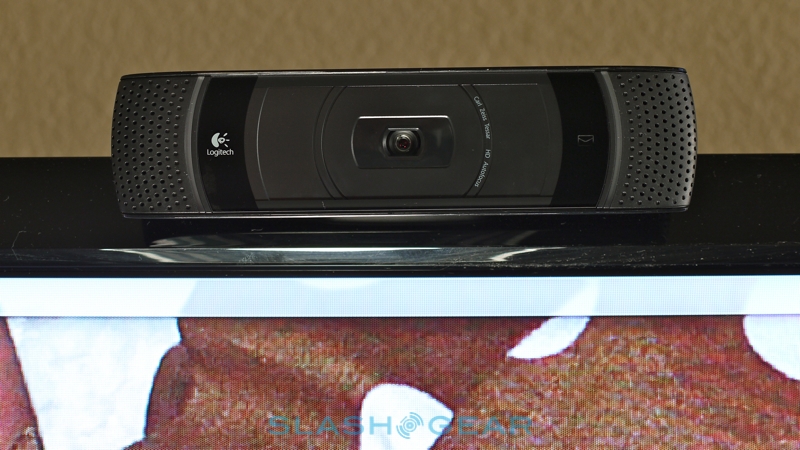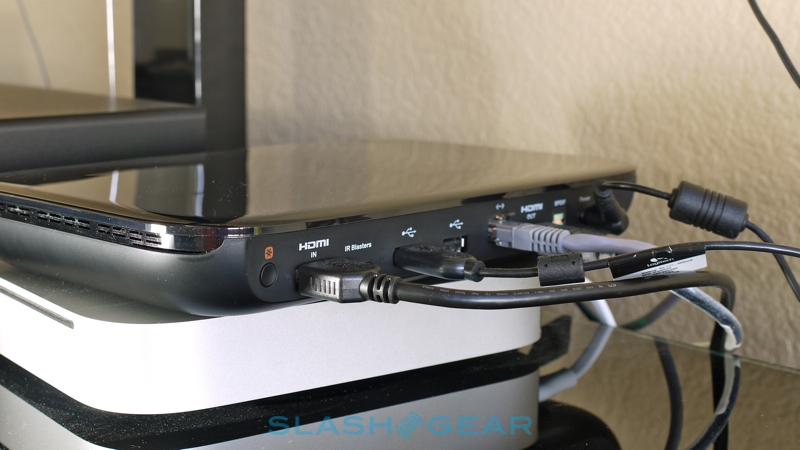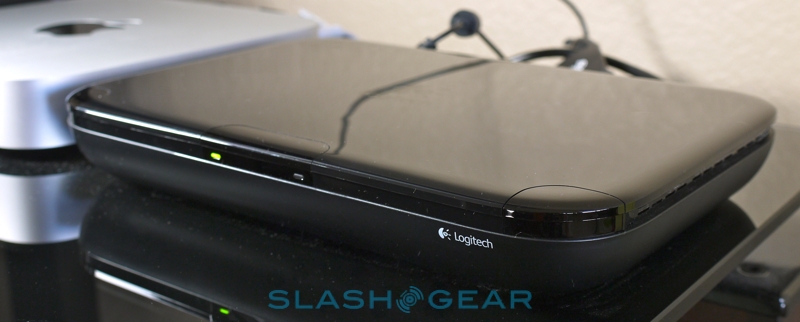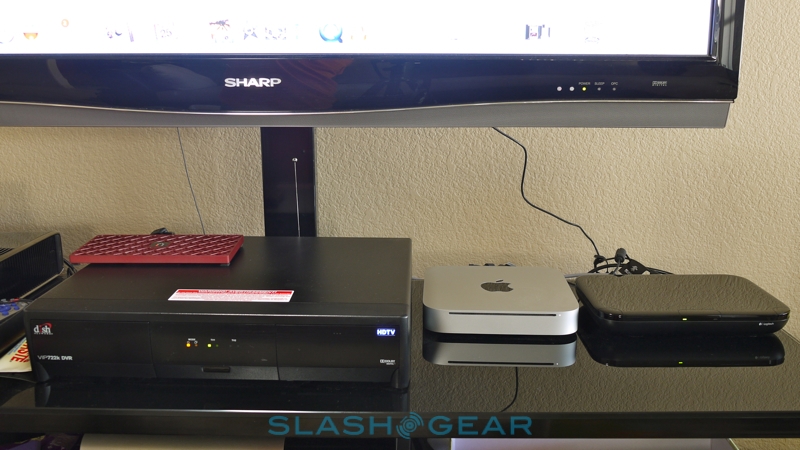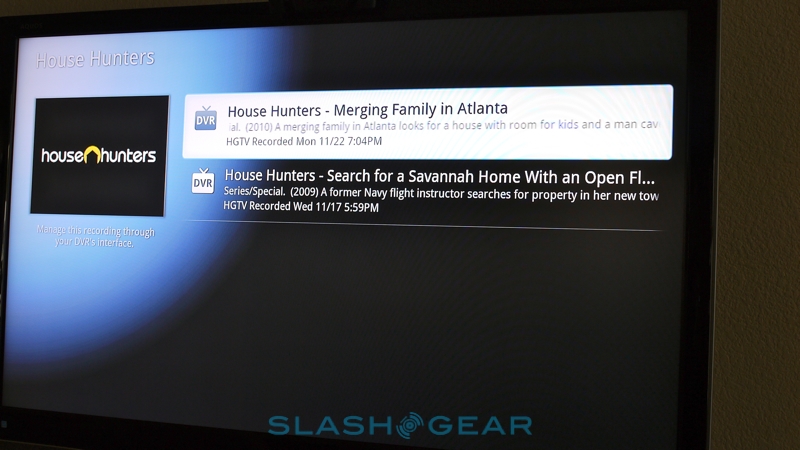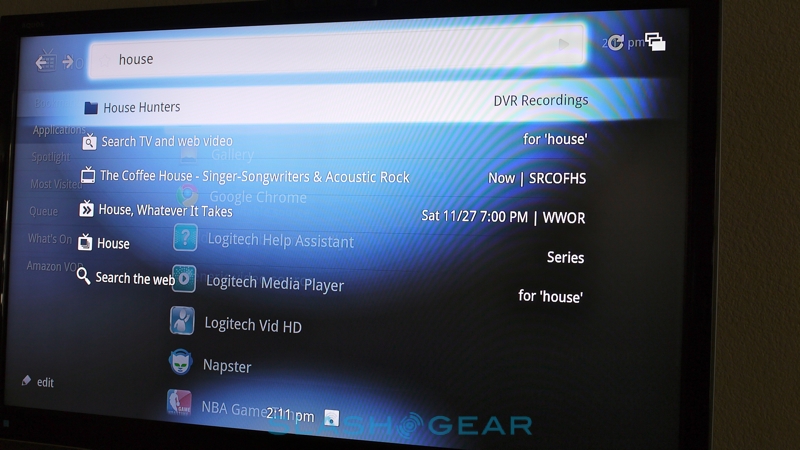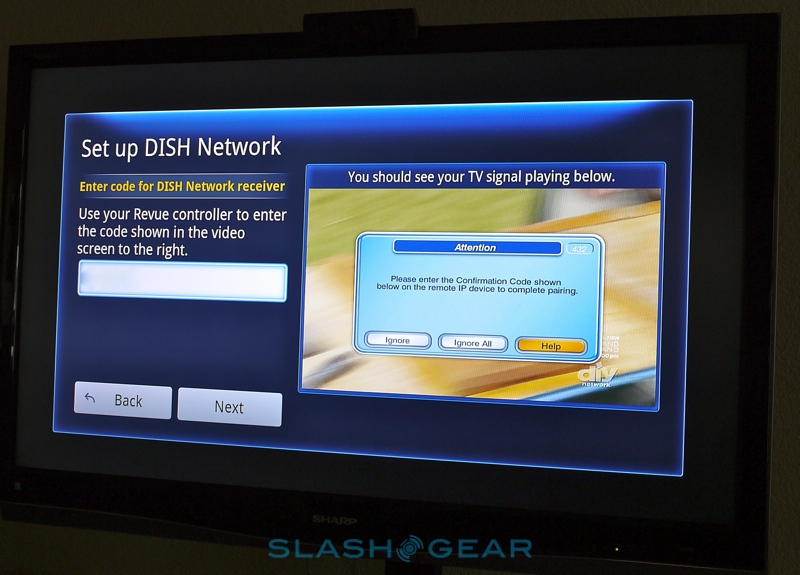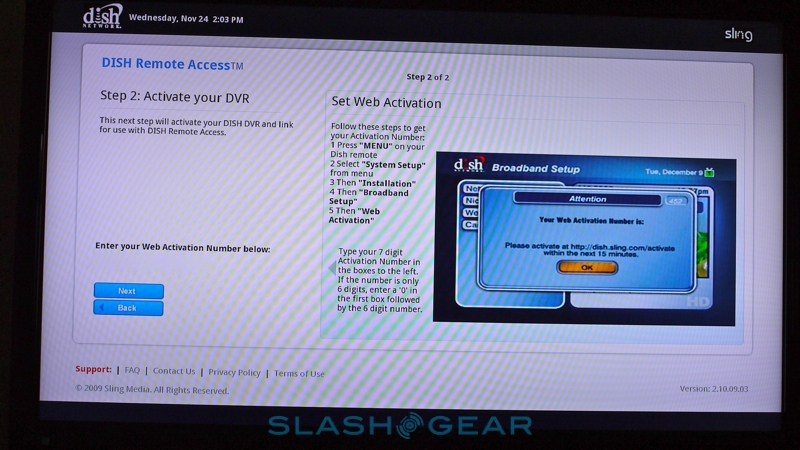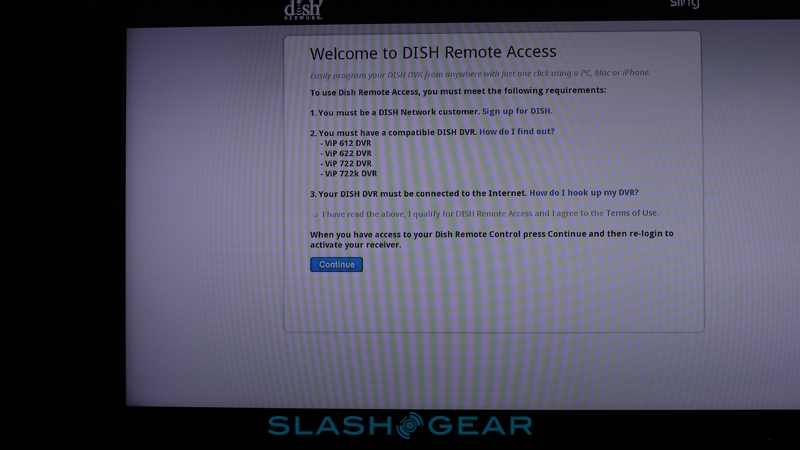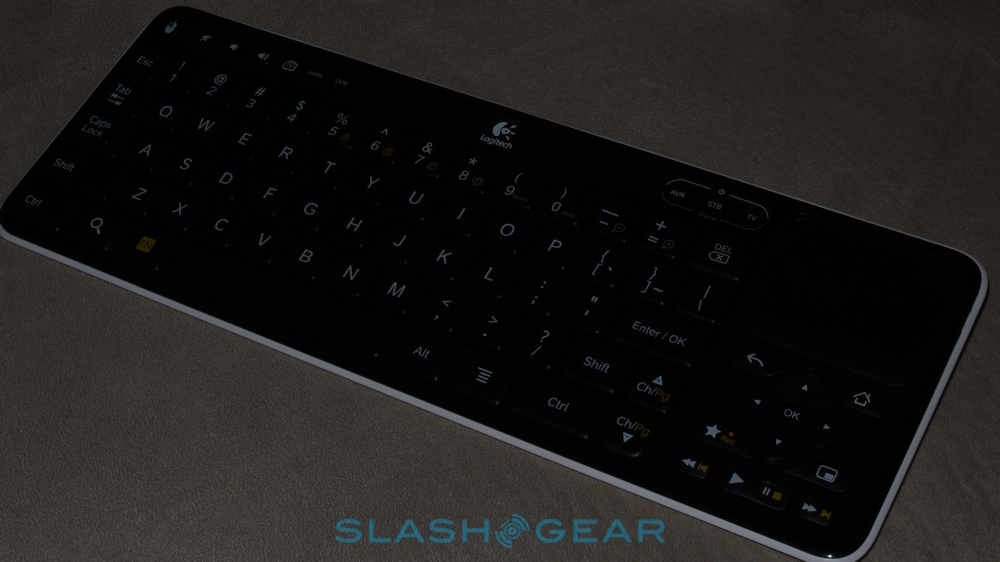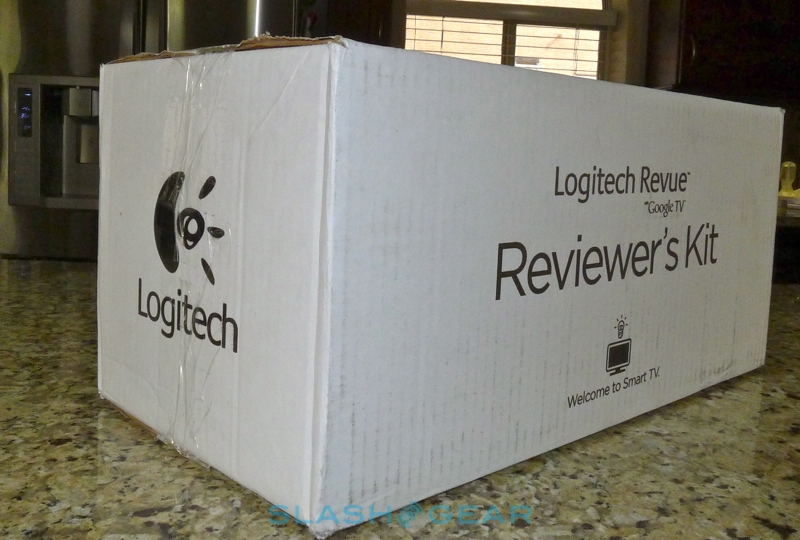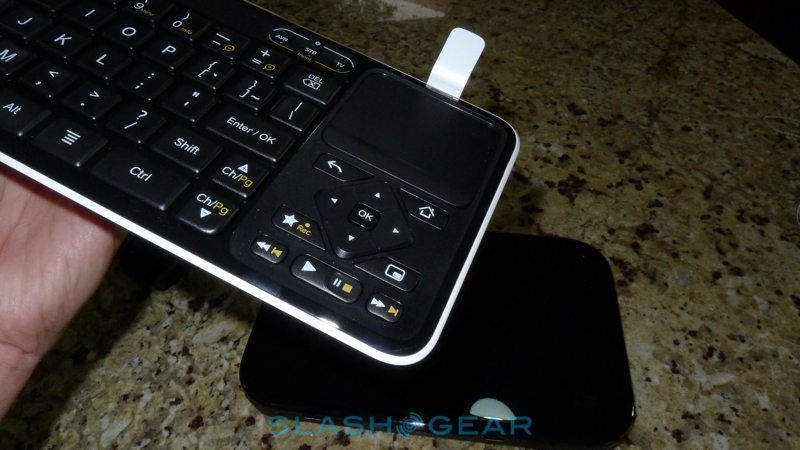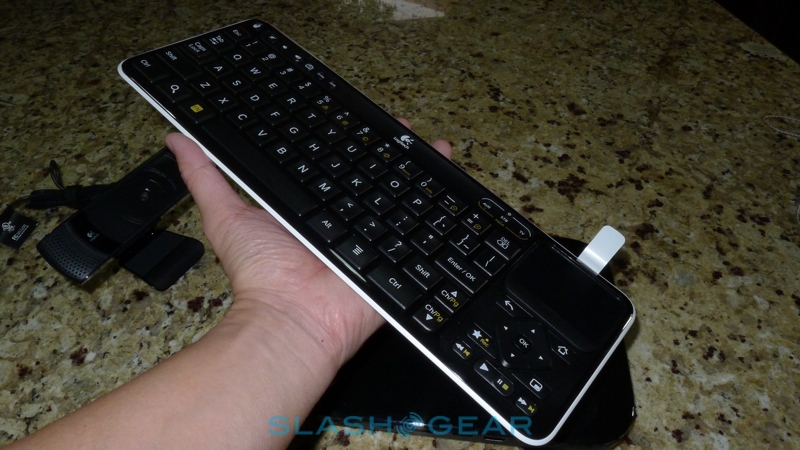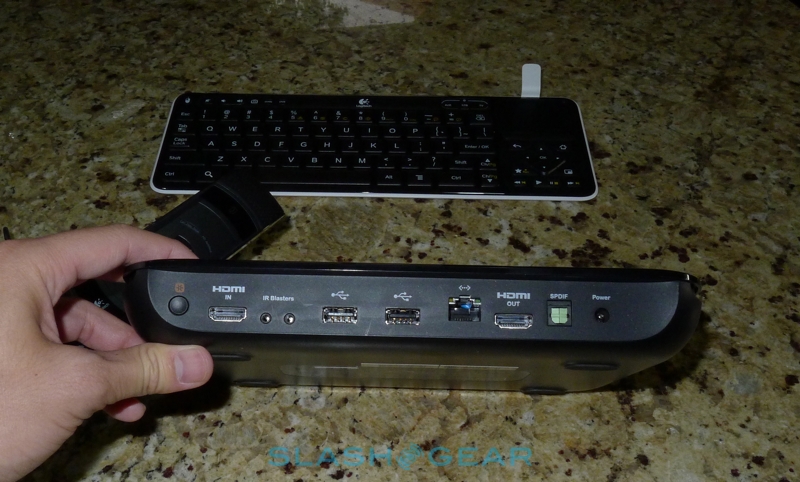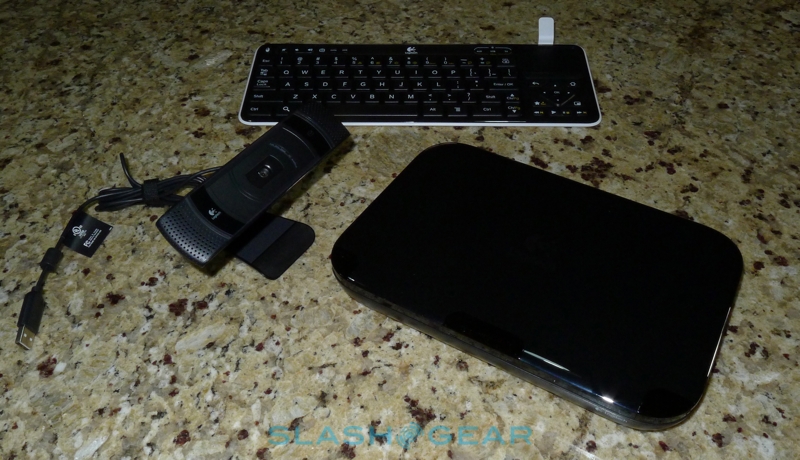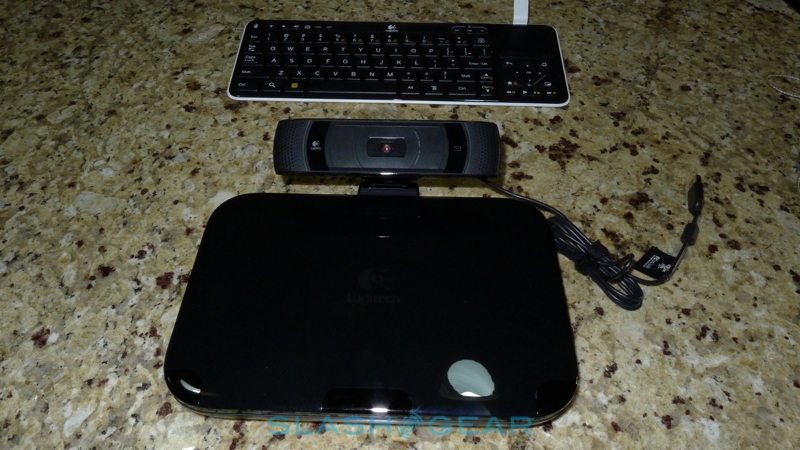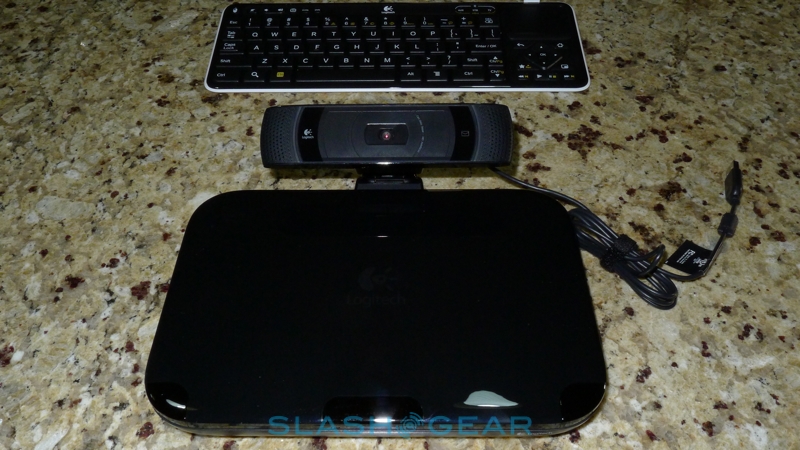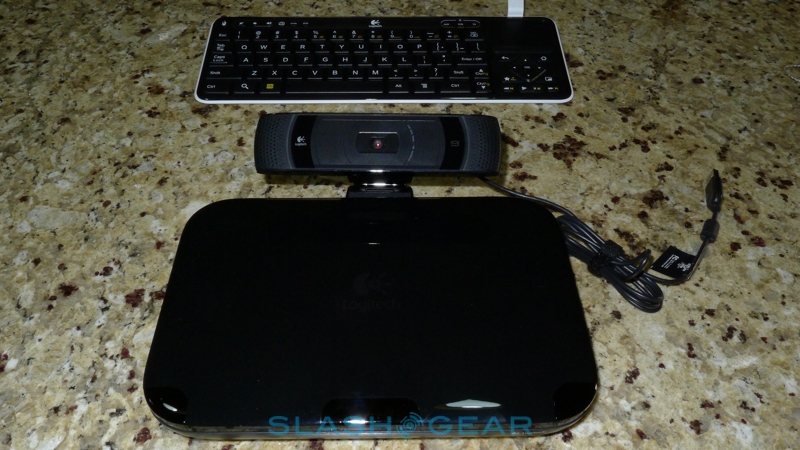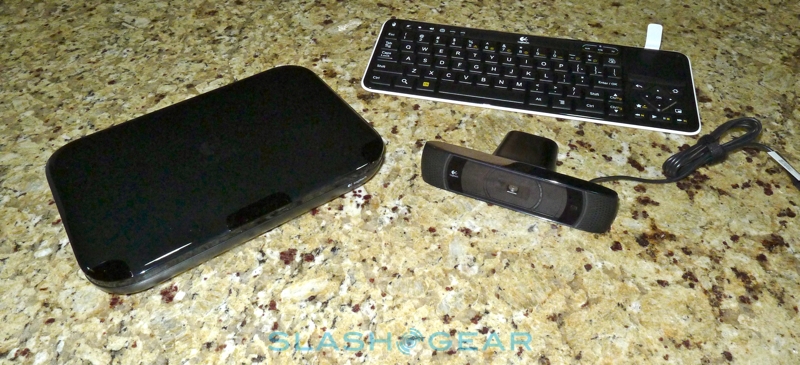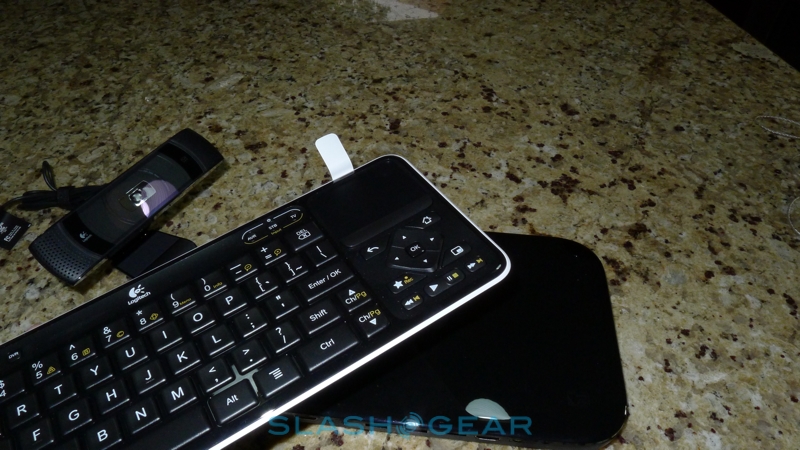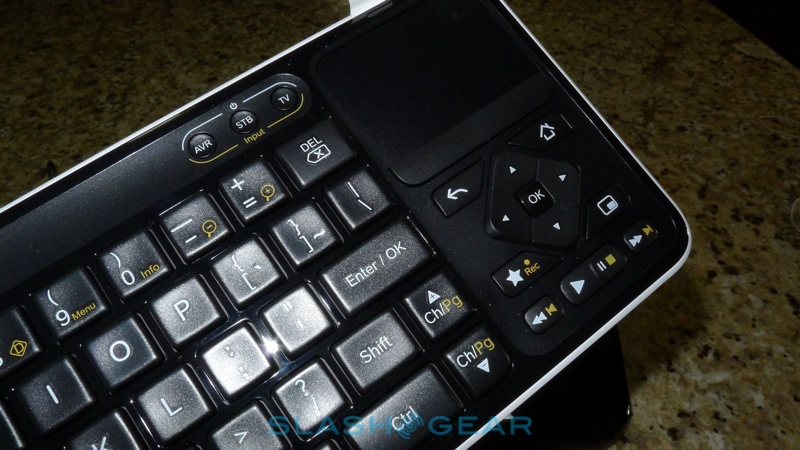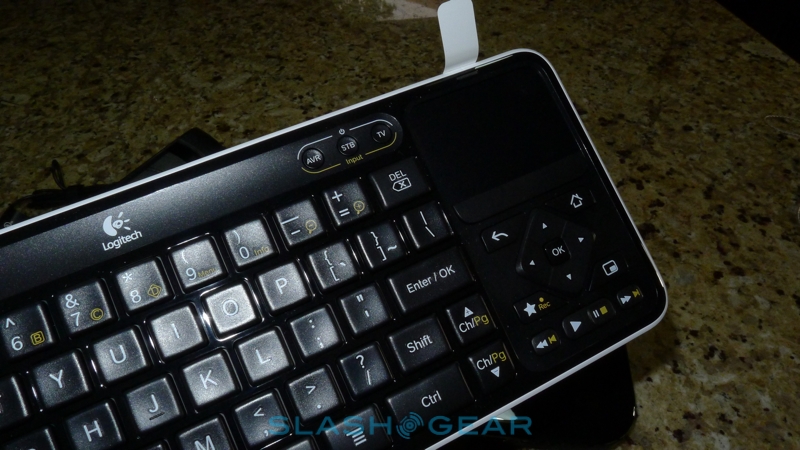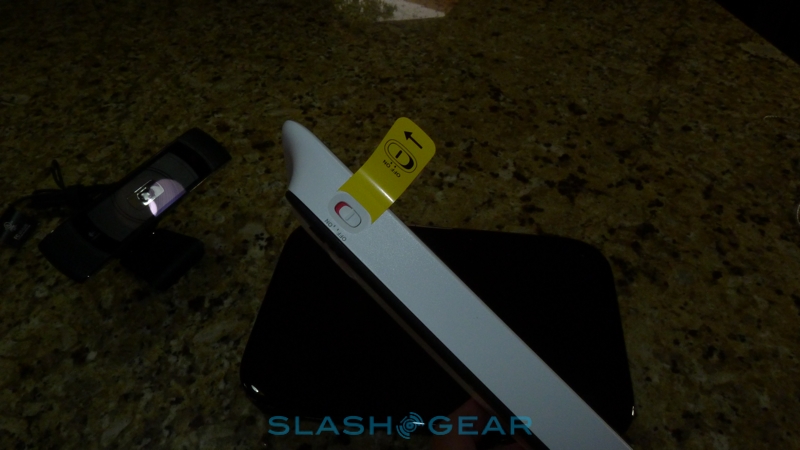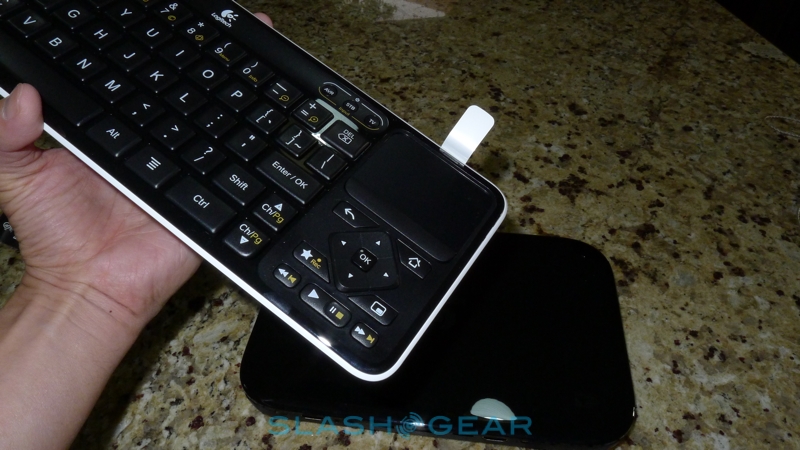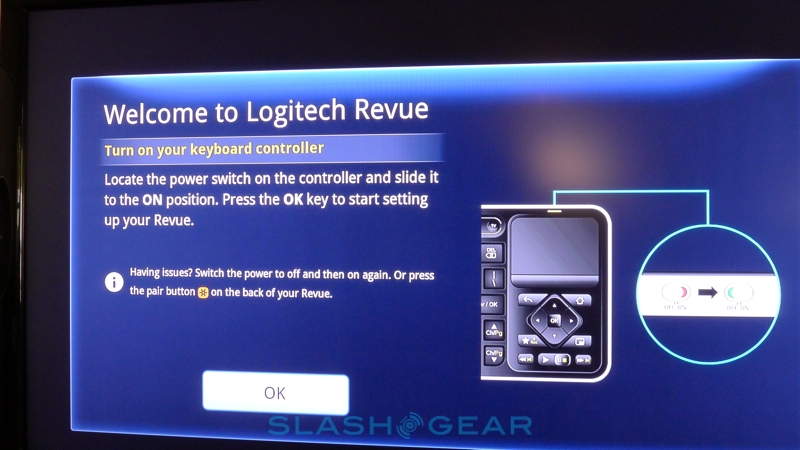Logitech Revue Review
You can't accuse Google of being unambitious. Not content with having their Android OS take great bites out of the smartphone market, the search giant has also put it to work as the core of Google TV, a new play for the home entertainment segment. Most early-adopters will dip their tow with the Logitech Revue, a compact set-top box with a not-so-compact $300 price tag. The promise is that Google TV harnesses the power of search and online media to the breadth of broadcast television, but does the Revue deliver? Check out the full SlashGear review after the cut.
Hardware
As STBs go, the Revue is relatively inoffensive in its design. A reasonably compact 247 x 171 x 36 mm box, it's finished in matte and gloss black plastic with a couple of indicator LEDs up front but no display or channel indicator, as you might find on a cable or satellite tuner. On the back there's an HDMI input and an HDMI output, two IR blaster ports for using the optional IR wand Logitech includes, a pair of USB 2.0 ports, ethernet and S/PDIF, together with a power port. The Revue's PSU is an external, laptop-style block.
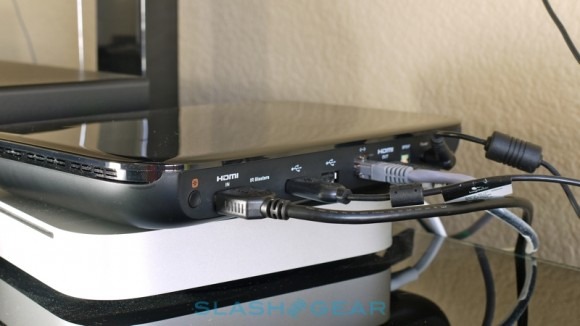
Inside, meanwhile, is Intel's CE4100 SoC, a combination of the company's 1.2GHz Atom CPU and an HD-capable GPU. Most other STBs – like the Apple TV – use low-power ARM based chipsets, which often require no active cooling, but the Revue gets a ducted fan. It's not obtrusively loud in operation, however.
Also in the box is Logitech's standard Google TV controller, a wireless keyboard with integrated trackpad and multimedia buttons. It's a sturdy, reasonably tactile device, but it's certainly not discrete, and if you find regular button-encrusted remotes off-putting then the Revue's 'board will likely smack a little too much of the home office. As you'd expect from a peripheral manufacturer, the keys are solid for typing and we had no problems with connectivity, though we'd prefer it if there had been key backlighting for easier nighttime use. Logitech offer a separate mini keyboard, priced at a hefty $130, which is better scaled to the living room, but we can't help but look at the Boxee Box remote – with its simple controls on one face and a scaled down QWERTY thumbboard on the reverse – and wish Logitech had done something similar.

Alternatively, Logitech offer smartphone apps for iOS and Android, so you can turn your cellphone into a Revue controller. Given the popularity of both platforms it's a sensible decision, and the apps are functional if lacking in some user-friendliness, but they're also relatively basic. Despite the Harmony branding – as with Logitech's range of multi-function remotes – they'll only control the Revue and there's no overall macro support for things like turning on the TV, powering up your surround sound amp and getting Google TV going all from a single button press. The apps also use Bluetooth to hook up, rather than WiFi, which limits their potential for whole-house controllers (say, if you're piping your Google TV output through some sort of wireless extender to a second set in the bedroom). The official controllers use Logitech's own 2.4GHz Unifying wireless system.
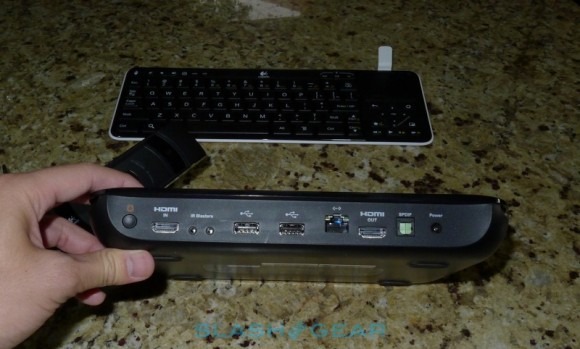
Hooking up your existing A/V kit is relatively straightforward, as long as you have the right ports to choose from. All Logitech includes is a single HDMI cable, so that you can slot the Revue in-between your cable/satellite STB and your TV. If you've been using anything other than HDMI then you're out of luck; Sony's Google TV Blu-ray player supports component inputs/outputs as well as HDMI, but Logitech's does not. The only real option is the S/PDIF output, useful if you use a separate A/V receiver for audio. Network connectivity, meanwhile, is either via 10/100 ethernet or integrated WiFi a/b/g/n.
Since the Revue can control whichever STB it's plugged into, the IR blasters are particularly important. Happily they work well, and since Google TV is only designed to control a single STB source (rather than, say, your cable box, amplifier, and various other sources) we had no issues getting things positioned effectively. DISH Network subscribers get even greater integration, as long as they have a VIP 622, 722 or 722K DVR and are willing to pay $4 extra per month as an "integration fee." Then, the two devices communicate over your home network, rather than using the IR blasters.
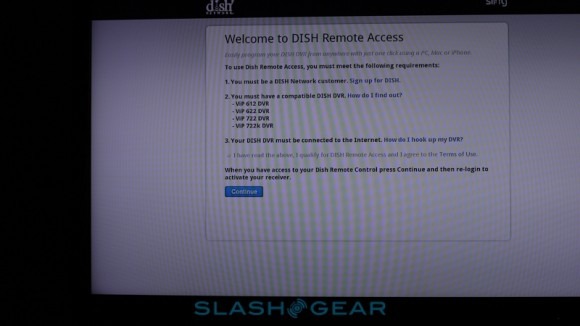
Google TV supports video calls, though Logitech's package doesn't come with all the necessary hardware as standard. Instead, you'll need the TV Cam webcam, an expensive $149 addition that plugs into one of the USB 2.0 ports on the back of the Revue (we'd like to have seen a front-panel port as well). Regular USB webcams won't work, unfortunately, since the TV Cam has its own 720p hardware encoding kit inside, though video calls can be held with anyone using Logitech's free Vid HD software, available for PC and Mac.
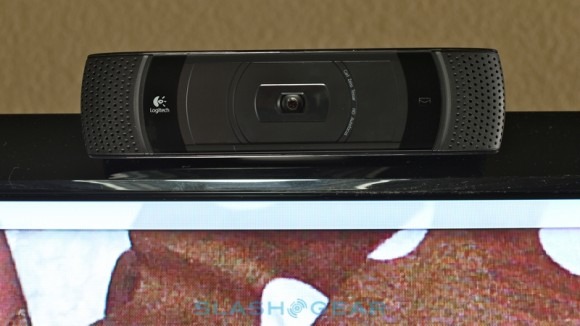
Software
DISH DVRs aside, Google TV attempts to be as flexible as possible in what STB kit it works with. The flip side of that flexibility is a nebulous, lengthy setup process that is likely to instantly sour the experience of any less-than-confident users. Various stages for setting up the WiFi or network connection (though not accommodating fixed IPs, unfortunately) together with picking your STB from a list, choosing which channels you do and don't get, a four-stage process of adjusting screen scaling to suit your display, and generally tweaking the Google TV experience – all punctuated with several restarts along the way – means the Revue really is not plug-and-play.
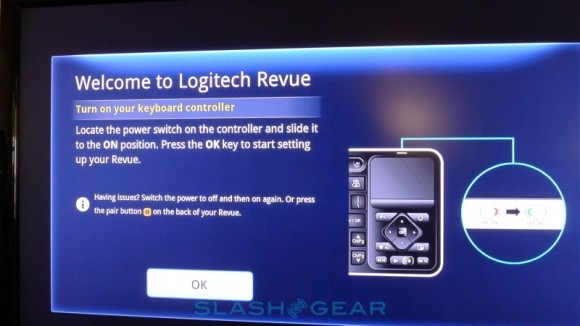
Although Android is the underlying OS, the UI is very different from an Android smartphone. As with most TV GUIs, Google TV's floats semi-transparent over the current show, app or browser window. It's made up of a list of general categories down the left hand side – such as bookmarks, most viewed content and, if you have access, Amazon Video On Demand – with thumbnails on the right. The "What's On" option gives a list of currently showing programs on broadcast TV, though there's no full EPG (electronic program guide) – instead you have to flick over to your STB's guide and navigate from there.
In fact, the experience as a whole feels more suited to immediate viewing than planning ahead. Unless you have one of the compatible DVR boxes, there's no easy way to schedule recordings from the Google TV UI: instead you get a pop-up box telling you to flip over to your DVR and set up the recording from there. If you've a DISH box, the Revue can schedule recordings itself.
Google is known for search, and so unsurprisingly Google TV makes heavy use of its search bar. Hit the dedicated button on the remote, and you can search through current and upcoming programs, channels, web content and online video. It's fast and it works, for general navigation, surprisingly well. Since Google TV knows what's showing on the channels you receive, you can type in a show name or a suitably notable detail – a team name for a sports game, for instance – and it will automatically flick over using the IR blaster. If you've a DISH DVR it will also pull up any recordings on that STB as well.
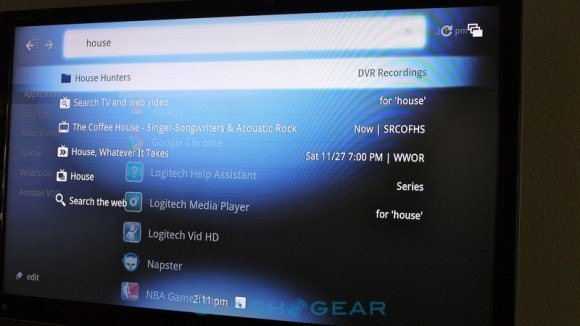
Unfortunately, the Revue's flexibility can lead to some confusion with searches, primarily when it's unclear whether you're running a generic query or an in-app search. Some software, such as the pre-loaded Twitter client, default to an in-app search and there doesn't appear to be a way to change it. On more than one occasion we found ourselves hitting the search key, typing in a term and then having to go back to the homescreen and re-search once we realized the active app had been hogging the search functionality. Adding even more confusion is the fact that, as on Android phones, the search bar also functions as the address bar in the Google TV browser (more on which in a moment).
Although searches through broadcast content work well, online media is generally less successful. Google's system can pull up streaming video results from YouTube and TV network sites, as well as Amazon Video On Demand and Netflix (if you have an account). When it works, it's great – you get both paid and free options, depending on what's available, and Netflix worked just as it does with a regular Roku box – but unfortunately much of the time the results were surprisingly patchy. Even high-profile titles often failed to show up, even though we knew they were available through at least one streaming service, and we also found that it would sometimes show us content that we actually could not watch through the Revue.
This last point is a tricky one, since it's not entirely Google's fault. While on the Internet the "everything is freely accessible" paradigm has been good to the search company, the TV industry is less willing to share its bounty without taking some sort of tithe. Since Google TV's launch, several high-profile networks have blocked access to devices like the Revue; meaning users can't stream their shows with Google's system. Right now that includes ABC, CBS, NBC, Fox and Viacom, as well as providers such as Hulu. Confusingly – for users, at least – those same sites (and their content) is watchable via a regular desktop browser, so hooking up a netbook or similar to your HDTV might actually net you a better range of viewing options than the dedicated Revue.
When it works, streaming video is opened in a custom build of Google's Chrome browser, complete with Flash Player 10.1 support for 1080p-accelerated video. You can obviously use this browser to view regular sites as well, though we found text could often be unpleasantly small and we spent much of our time hitting the zoom button to toggle font sizes. The Flash support is only for video, too, so Flash games are out. We were disappointed by the sometimes-jerky performance, which falls short of browsing on an Android-based smartphone or tablet.
Multiple Chrome windows are supported, and holding the Home button the keyboard brings up thumbnails of every tab together with the homescreen and the bare TV view. It's straightforward to navigate through them using the arrow keys. There's also DualView, a browser/TV picture-in-picture, which puts the currently showing TV feed in a small box in the bottom right hand corner. Useful, but not as much as if you could resize the window, move it elsewhere in the screen, or indeed – as you can usually do with PiP on regular TVs – switch the two views around. Bizarrely, you can't open DualView from within the browser, even though there's a dedicated button on the remote. Instead, you have to be watching TV initially, and then hit the button to shrink down the video and open up the browser.
Google preload a small selection of applications onto Google TV, though the flexibility of this will extend considerably once the Google TV Marketplace arrives sometime in 2011. As it stands, there are Netflix, CNBC, Napster, Pandora, Picasa, Twitter and NBA apps currently available, with varying degrees of complexity. Unlike Netflix on other platforms, for instance, you can access your Instant Queue but not add titles to it from the app itself (since the Netflix site is available from within Chrome, you can always add titles there and then jump back over to the app). They work, but it'll take third-party investment to make it all worthwhile, and by the time that happens it's possible that Apple will have already brought the weight of its App Store to the Apple TV.
Wrap-Up
There's no denying that Google TV – and the Logitech Revue – has potential. Unfortunately, much of that potential is currently only part delivered on. The downside to Google TV's all-encompassing compatibility is that it can feel decidedly average across the board, rather than a close-knit experience with just a few devices. DISH Network support is, right now, the pinnacle of Revue integration, and even that feels half-hearted. Temperamental browsing is not what we expect from a device which positions the search experience as its core strength, and nor are patchy search results.
Hardware and software shortcomings are just one aspect of the story, however, and it's content, which is somewhat outside Google's control. When the Revue's streaming works, it works well; sadly the networks don't seem all too keen on allowing Google TV a free ride on their online media. The list of blocked sites looks only likely to get longer, and at that point someone – Google, users, or both – will have to reach into their pockets and pay up for access. Whether that model fits in with Google's long-term plans for Google TV, or indeed sits comfortably with a $300 STB, remains to be seen. You pay $99 for an Apple TV with the understanding that content costs a few dollars a time; do you feel as comfortable when the Revue is three times that amount and the content landscape is so changeable?
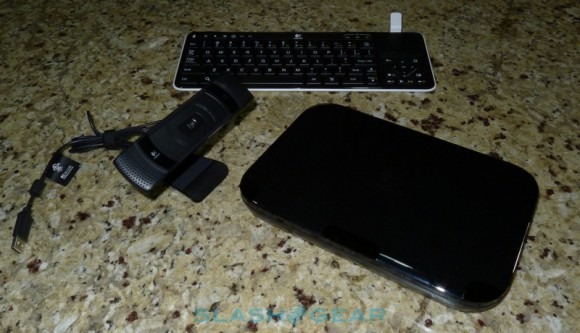
As we've seen with Android on smartphones, once Google starts with its iterative updates there's little stopping it. Unfortunately, it also means that early adopters suffer the pain of v1.0 hardware and software, and a user experience that can end up only vaguely resembling the original promise as service and content providers alike find their feet. The Logitech Revue is certainly not ready for primetime, but give Google TV a few more rehearsals and there are glimpses of star potential.

